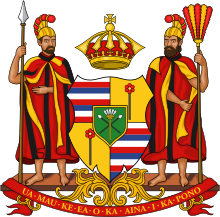For other persons with this name, please see Kamanawa II.
| Kamanawa | |
|---|---|
 On the left is Kamanawa | |
| Died | c. 1802?[1]: 106 |
| Spouse | Kekelaokalani Kekuʻiapoiwa II |
| Issue | Koahou Noukana Amamalua Peleuli Kekelaokalani Piʻipiʻi Kalanikaulihiwakama |
| Father | Keawepoepoe |
| Mother | Kanoena |
Kamanawa (died c. 1802?) was a Hawaiian high chief and early supporter of King Kamehameha I, known as one of the royal Nīʻaupiʻo twins with his brother Kameʻeiamoku. He later became the stepfather of Kamehameha by marrying his mother.
Life
editKamanawa's father was Keawepoepoe.[citation needed] His mother was Kanoena, sister of his father.[2] His namesake grandnephew Kamanawa II (grandson of his twin) was grandfather of the last two ruling monarchs of the Kingdom. The name ka manawa (sometimes spelled "Ka-manawa") means "the season" in the Hawaiian language.[3]
His first wife was named the High Chiefess Kekelaokalani of Maui, the daughter of his aunt, Queen Kekuiapoiwanui of Maui, by her second marriage to High Chief Kauakahiakua-o-Lono of Maui.[citation needed] His second wife was Chiefess Kekuʻiapoiwa II, the mother of Kamehameha I. He had three sons: Koahou, Noukana, and Amamalua from his first wife. He also has a daughter Peleuli, who became a consort of King Kamehameha,[4] by his first wife and a daughter Piʻipiʻi Kalanikaulihiwakama by his second wife.
Since his double grandmother Kalanikauleleiaiwi was Kamehameha's great-grandmother, they were half-cousins once removed by blood. However, he was also father-in-law and stepfather to Kamehameha, so was called his uncle.
He most likely died around 1802.[1]: 106
Ancestry
edit|
Family tree based on Abraham Fornander's; "An Account of the Polynesian Race" and other works from the author, Queen Liliuokalani's; "Hawaii's Story by Hawaii's Queen", Samuel Mānaiakalani Kamakau's; "Ruling Chiefs of Hawaii" and other works by the author, John Papa ʻĪʻī's; "Fragments of Hawaiian History", Edith Kawelohea McKinzie's; "Hawaiian Genealogies: Extracted from Hawaiian Language Newspapers, Vol. I & II", Kanalu G. Terry Young's; "Rethinking the Native Hawaiian Past", Charles Ahlo, Jerry Walker, and Rubellite Kawena Johnson's; "Kamehameha's Children Today", The Hawaiian Historical Society Reports, the genealogies of the Hawaiian Royal families in Kingdom of Hawaii probate, the works of Sheldon Dibble and David Malo as well as the Hawaii State Archive genealogy books.
Notes:
| |||||||||||||||||||||||||||||||||||||||||||||||||||||||||||||||||||||||||||||||||||||||||||||||||||||||||||||||||||||||||||||||||||||||||||||||||||||||||||||||||||||||||||||||||||||||||||||||||||||||||||||||||||||||||||||||||||||||||||||||||||||||||||||||||||||||||||||||||||||||||||||||||||||||||||||||||||||||||||||||||||||||||||||||||||||||||||||||||||||||||||||||||||||||||||||||||||||||||||||||||||||||||||||||||||||||||||||||||||||||||||||||||||||||||||||||||||||||||||||||||||||||||||||||||||||||||||||||||||||||||||||||||||||||||||||||||||||||||||||||||||||||||||||||||||||||||||||||||||||||||||||||||||||||||||||||||||||||||||||||||||||||||||||||||||||||||||||||||||||||||||||||||||||||||||||||||||||||||||||||||||||||||||||||||||||||||||||||||||||||||||||||||||||||||||||||||||||||||||||||||||||||||||||||||||||||||||||||||||||||||||||||||||||||||||||||||||||||||||||||||||||||||||||||||||||||||||||||||||||||||||||||||||||||||||||||||||||||||||||||||||||||||||||||||||||||||||||||||||||||
References
edit- ^ a b Kameʻeleihiwa, Lilikalā (1992). Native Land and Foreign Desires. Bishop Museum Press. ISBN 0-930897-59-5.
- ^ McKinzie, Edith Kawelohea (1986). Edith Kawelohea McKinzie; Ishmael W. Stagner (eds.). Hawaiian genealogies: extracted from Hawaiian language newspapers. ISBN 9780939154371.
- ^ Pukui and Elbert (2003). "lookup of manawa". on Hawaiian dictionary. Ulukau, the Hawaiian Electronic Library, University of Hawaii. Archived from the original on 2012-07-16. Retrieved 2009-12-26.
- ^ Henry Soszynski. "Kamanawa I". web page on "Rootsweb". Archived from the original on 2012-10-24. Retrieved 2009-12-26.